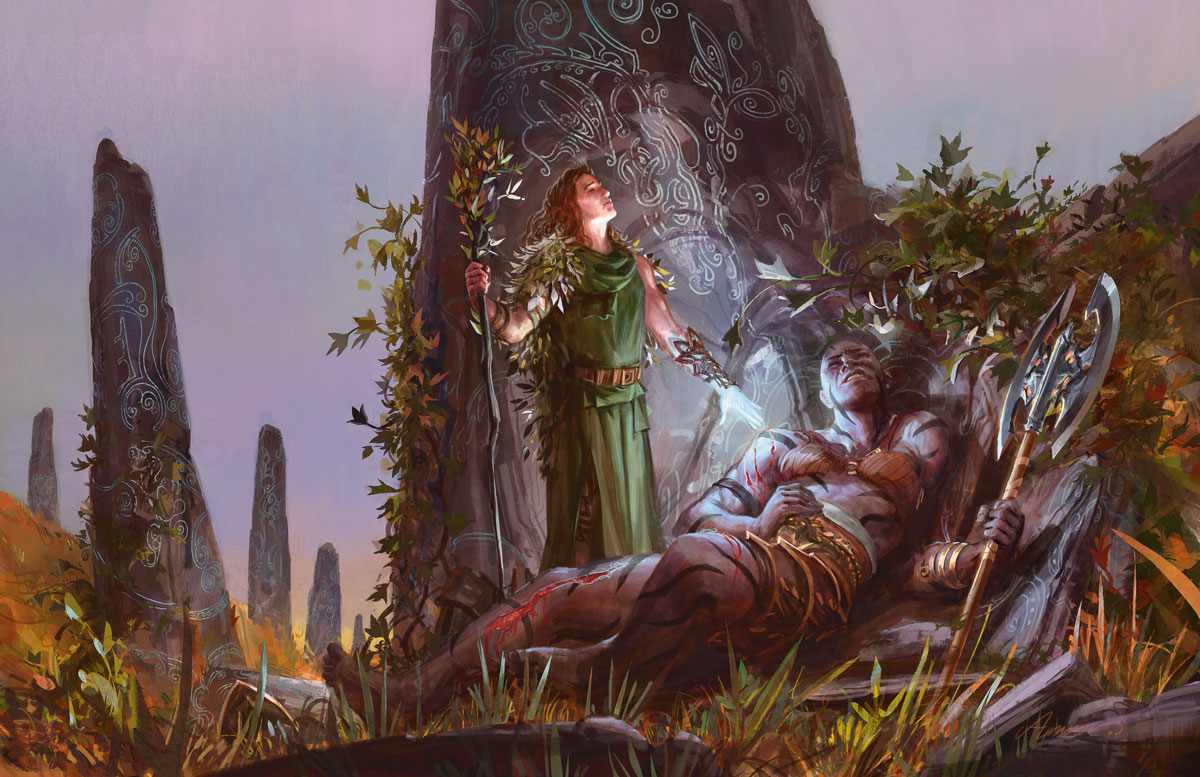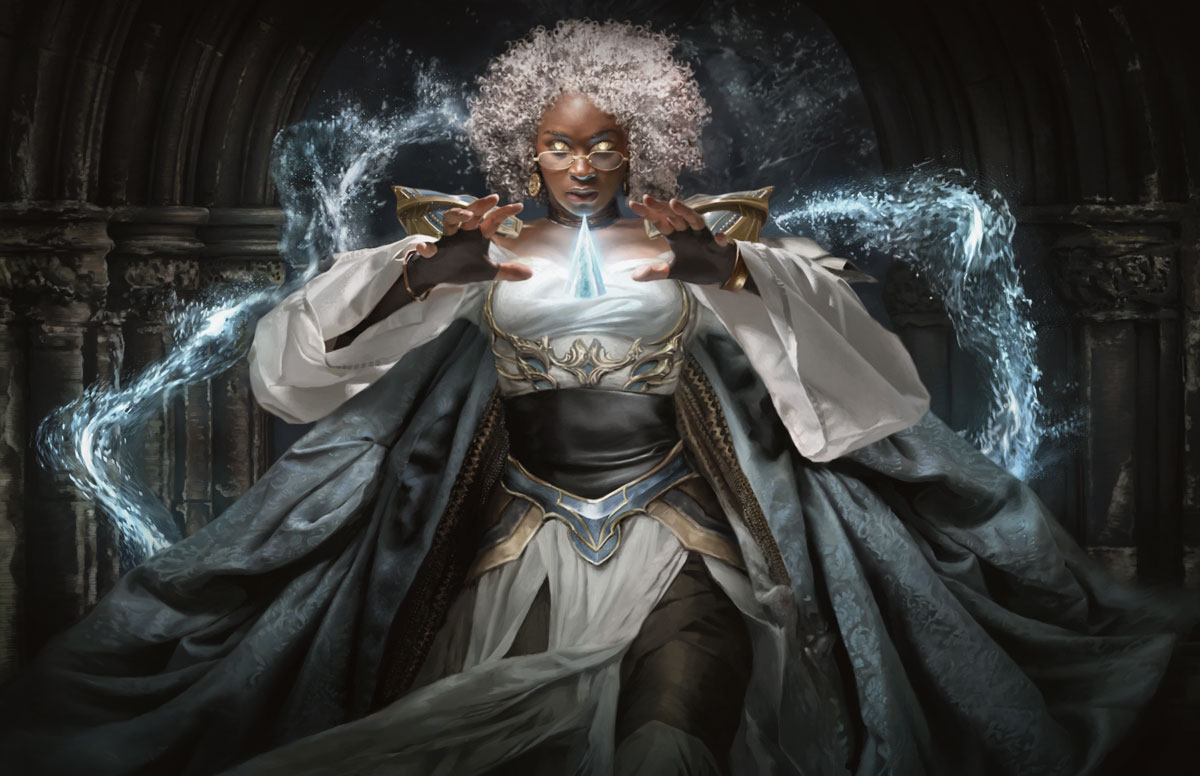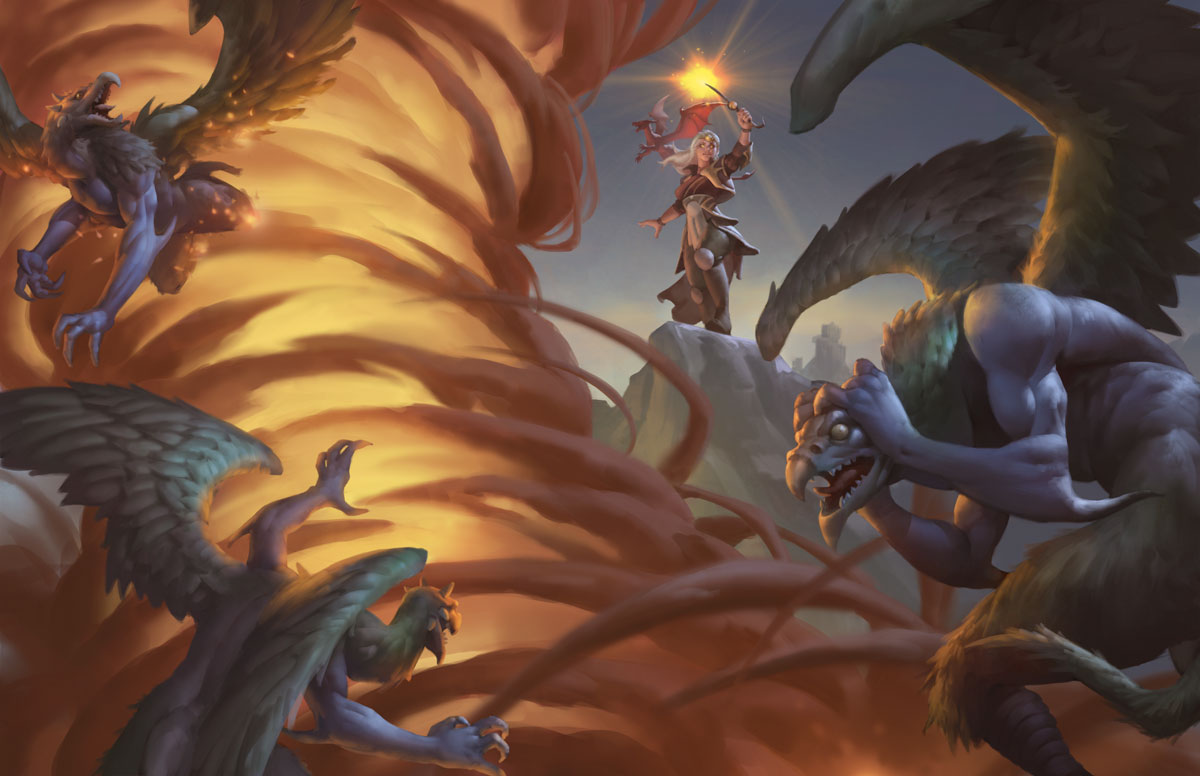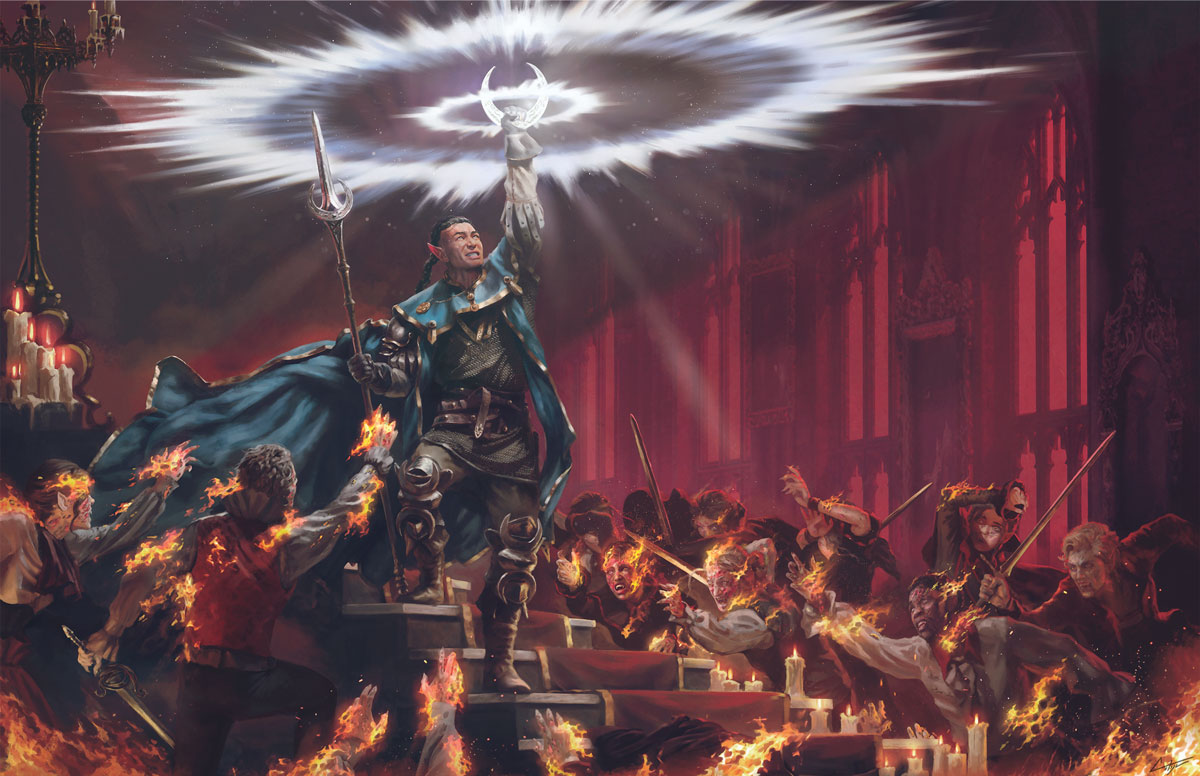Magic is one of the main elements that make Dungeons & Dragons so cool. Whether you’re pulling the Weave, strumming along to the Words of Creation, or drawing forth the divine power of your chosen deity (or patron!), using spells can give you the ultimate power fantasy: The ability to literally reshape the world around you. That’s why the 2024 Player’s Handbook is bringing you over a hundred pages of spells. You’ll find boosts to classic favorites, popular spells from sourcebooks being ported to the core rules, and even some brand-new spells!
In this article, we’ll discuss some of the overarching changes you’ll see with spells and even show you some of the new spells introduced in the 2024 Player’s Handbook.
- Many Favorite Spells Have Been Boosted
- It’s Easier to Find and Use Your Favorite Spells
- New Spells for the Core Rules
- Emanation Area of Effect
The 2024 Player’s Handbook is Now Available!
Buy the 2024 Player’s Handbook today and dive into revised rules, enhanced character options, and exciting gameplay innovations.
Get your copy on the D&D Beyond marketplace and seamlessly integrate your new content with D&D Beyond's library of digital tools built to make D&D easier, so you can focus on the fun!
Many Favorite Spells Have Been Boosted

One of the first things that long-term D&D players will notice when perusing the almost four hundred spells in the 2024 Player’s Handbook is that many of your favorite spells have been buffed up.
Your healing spells will keep you and your allies on your feet longer to reflect the cost of your action or Bonus Action and your spell slot in order to use them. For example, Cure Wounds now heals a base of 2d8 + your spellcasting modifier, and Healing Word similarly has a base of 2d4 + your modifier as a level 1 spell. And it’s not just dice increases. Many spells receive a new element of functionality. Prayer of Healing, which takes 10 minutes to cast, now grants the benefits of a Short Rest to up to five creatures in addition to restoring 2d8 Hit Points.
Damage-dealing spells have seen several boosts too. Cloud of Daggers used to have some diminishing returns on later rounds if enemies started to avoid your cube of swirling stabs. But that’s a thing of the past, because now you can use a Magic action on your later turns to move the cloud up to 30 feet. Similarly, Chromatic Orb has been updated with the potential to strike an additional enemy, really embracing the dodgeball vibe or chucking a magically infused sphere at your enemies.
A number of spells that saw little use from the 2014 Player’s Handbook version also saw some tweaks to make them more functional and enticing for you to add to your repertoire. Blade Ward, for example, was a fairly underused cantrip because it cost an action, only lasted a turn, and only granted resistance to Bludgeoning, Piercing, and Slashing damage for that one turn. Now, while it still takes a Magic action, this cantrip lasts for a full minute, with Concentration, and forces all enemies attacking you to subtract 1d4 from their attack roll for the duration.
These are just a few of the changes to some known spells, so be sure to look for your favorite spells in the 2024 Player’s Handbook to see what changes may be in store for you!
It’s Easier to Find and Use Your Favorite Spells

Speaking of looking up your favorite spells, the 2024 Player’s Handbook makes the process of finding, preparing, and using your spells as a player easier.
Now, you no longer need to flip to the back of the book to see what spells are available for your class. Each class has its designated spells listed in the class description for the class itself in the Character Classes chapter. So if you’re building a Cleric, the list of Cleric spells is right there in the same section as your class features and domain subclasses.
One of the big missions in revisiting spells was to really listen to and address questions and confusions players have had around various spells in the decade since the 2014 Player’s Handbook was first published. We tightened up the wording in some spell descriptions to make them clearer and more succinct, without changing the actual mechanics of the spells. We provided more artwork of the spells in use to give you more inspiration for imagining how the spell looks when you cast it. The Ritual tag has now been moved to the casting time to make it easier to find since it impacts the casting time of a spell.
As an example of changes to spells, the conjuring family of spells, such as Conjure Fey and Conjure Celestial, have been updated to officially reflect popular modifications that were playtested in Unearthed Arcana. The new versions of the spells now give you all the information you need when casting them in the spell descriptions themselves; for example, Conjure Fey specifies that the conjured spirit can make a melee spell attack against a creature within 5 feet, and on a hit, the target takes Psychic damage and has the Frightened condition.
This saves you from cracking open the Monster Manual to track your conjured creature’s information and makes them operate more similar to the Spirit Guardians or Spiritual Weapon spells.
New Spells for the Core Rules

The 2024 Player’s Handbook introduces some brand-new spells to the D&D spellbook. Some, like the Starry Wisp cantrip, were included in the Unearthed Arcana playtests, but some weren’t and will be making their debuts in the 2024 spell list.
Some of the brand-new spells include ties to the known spellcasters within the D&D multiverse. Our old pal Tasha has a brand new spell, Tasha’s Bubbling Cauldron, which creates a magical cauldron for 10 minutes that you and your allies can reach into and grab vials of a Common or an Uncommon potion of your choice. Jallarzi, a Celestial Patron Warlock with the distinction of being a non-Wizard member of the Circle of Eight, has a powerful namesake spell, Jallarzi’s Storm of Radiance. This spell creates a raging 40-foot cylinder storm that deals Radiant and Thunder damage. It also gives creatures within it the Blinded and Deafened condition and makes them unable to cast spells with a Verbal component.
Popular spells from the expanded sourcebooks have also now become part of the core spell list. Some, like Toll the Dead, introduced in Xanathar’s Guide to Everything, have gotten so ubiquitous that many don’t realize they weren’t initially part of the 2014 Player’s Handbook.
Emanation Area of Effect

Emanation is a new area of effect, joining known types like Cone, Line, or Sphere. An Emanation spell extends in a straight line in all directions from a creature or object, and moves with them if the spell duration is longer than Instantaneous. Emanation differs from a Sphere in that its origin is not considered part of the area of effect unless the Emanation’s creator decides otherwise (whereas a Sphere’s origin is always included in the area of effect). Known spells such as Thunderclap and Spirit Guardians are now classified as Emanation for their areas of effect.
This Spells Fun
The 2024 Player’s Handbook is now available on the D&D Beyond marketplace, which means it's time to set out on new adventures with fresh or familiar characters!
With almost four hundred spells spread across over a hundred pages, we’ve clearly only scratched the surface of the exciting changes coming to your spellcasting with the 2024 Player’s Handbook. Be sure to look through the complete spell list for your preferred spellcaster to see what changes are in store for your favorite spells, and what new spells are ready for you to play with.
We’re delighted to share with you the changes to fifth edition D&D that appear in the 2024 Player’s Handbook. Make sure to keep an eye out on D&D Beyond for more useful guides on using the wealth of new options, rules, and mechanics found in the 2024 Player's Handbook!

Riley Silverman (@rileyjsilverman) is a contributing writer to D&D Beyond, Nerdist, and SYFY Wire. She DMs the Theros-set Dice Ex Machina for the Saving Throw Show, and has been a player on the Wizards of the Coast-sponsored The Broken Pact. Riley also played as Braga in the official tabletop adaptation of the Rat Queens comic for HyperRPG, and currently plays as The Doctor on the Doctor Who RPG podcast The Game of Rassilon. She currently lives in Los Angeles.
This article was updated on August 13, 2024, to issue corrections or expand coverage for the following features:
- It’s Easier to Find and Use Your Favorite Spells: Added Conjure Fey as an example of how the new spell listing works.
- New Spells for the Core Rules: Remove plurality in the Tasha’s Bubbling Cauldron sentence to avoid confusion.
- Emanation Area of Effect: Clarified that the Emanantion’s creator can choose to include the origin in the area of effect.








-
View User Profile
-
Send Message
Posted Jul 20, 2024It's welcome to see that the Classes' spell lists will be given as part of the Class description rather than as a separate section. Are there also plans to improve indexing the other way, by adding to the Spell description a note of which Classes have it on their core* lists? It can be rather disappointing to leaf through the Spell list, see something that looks really thematic and suitable for a character, and then have to go on a great cross-referencing search to find out whether they can actually use it or not. (*Certain 2014 Subclasses got some of their 'free' spells from outside their core Class list. For sake of readability at the Spell end, I think we can assume that if you're building one of them you know about their special exceptions.)
-
View User Profile
-
Send Message
Posted Jul 30, 2024Not to get lost in the backstory but what is the reason(source) that that you consider Jallarzi Sallavarian a non-wizard?
-
View User Profile
-
Send Message
Posted Jul 30, 2024They needed warlock representation in 5e?
-
View User Profile
-
Send Message
Posted Jul 31, 2024lol! Let’s make a deal! That is a great analogy!
-
View User Profile
-
Send Message
Posted Jul 31, 2024So every caster with access will have Bladeward running continuously.
Player to DM. "I cast Bladeward."
DM to PC. "You aren'y in combat. I told that all we are doing for this session is managing downtime and the bastion, right?""
Player to DM. "Has a minute passed yet? If so, I cast Bladeward since the only resource it costs me is Concentration."
-
View User Profile
-
Send Message
Posted Aug 15, 2024I WANT Alignment to stay in the game and to be a factor. Its part of what makes DnD. People keep wanting to strip ALL the elements that make DnD unique and not samey on EVERYTHING....sheesh...
-
View User Profile
-
Send Message
Posted Aug 16, 20241. Racism towards in game fictional races do not concern me. In fact, again, its part of the worlds that IS DnD. I run my games with these elements just fine. DnD is all about breaking into some creatures home, looting their shit, killing their kin, and celebrating at the local pub. Drow are an evil race, YES. Same with the chromatic dragons..these are not "problematic" issues....unless you make to be in your own head.
2. Secondly, in the game its pretty clear what is seen as classically good and evil. I am all for moral relativism in the real world, but it doesnt have to be that complicated. Think Superman for good, and Darsied for evil. Play accordingly.
3. Oh no...there are "restrictons" to a player...how will one ever survive?? Again, I want these kind of restrictions. Make a choice and stick with it, or if you are so narratively inclined, you can gasp ROLEPLAY how you transition to a new one.
4. I disagree entirely that there shouldnt be mechanics tied to it. I think certain spells should be limited by alignment. I think Paladins should be limited to what Oaths they can take, and Druids need to be Neutral on one axis. These kinds of limits help to better define the classes/subclasses and make each one a meaningful choice. Its why I HATE the new Backgrounds, beyond moving the racial bonuses to them...they, like the Races, are all now just reskins. Its boring as shit. There should be some with more skills, or feats, well Attribute bonuses should be placed back to Races and then some more or less.Hell if people REALLY like the idea that backgrounds have some tie into Ability scores, then give some bonuses for Race and some for Backgrounds. At least that splits the difference.
5. Neocrotic IS inherently evil, and Radiant IS inherently good by the definitions of the lore of the game.
Look I get that new players have been taught their whole lives that a. they are special little snowflakes that nothing is ever supposed to be a challenge and they could NEVER fail, and b. that "every" opinion is valid but really that is wrong on both counts.
Beyond what I mentioned above, I also think Death Saves should be removed, and do so in my games. I have to fix the monsters to actually be the terrifying creatures that they are. Sure some monsters you MIGHT be able to discuss a deal with. But goblins, drow, etc are evil, they act evil and they will kill you...so go in their homes and kill them first. Ah, good ole dungeon diving. And I get that people seem to want to bake cookies for some reason, that is fine, but its not what I think of when I think DnD.
I am all for homebrewing, I am all for giving players options, and I am ALSO for having choices also potentially creating certain restrictions. And alignment is a very useful tool to helping inform roleplay...I am not saying you need to be a slave to it, usually, but I am saying that if you pick A and keep falling into actions more aligned with D, then change to D and move on. And let it be known, being "perfect" in keeping your alignment is, again historically, only going to matter to a couple key classes and the Atonement Spell was created for just that reason.
-
View User Profile
-
Send Message
Posted Aug 17, 2024Radiant damage is not inherently good - it slides the scale from radiation to sunlight to holy energy. Look at spells like Sickening Radiance, that creates an area of magical radiation that literally gives you levels of exhaustion and slowly microwaves you to death. There's nothing good-aligned about such a horrible spell. (I say horrible but I adore this spell)
Necrotic damage is anything that as to do with sapping your life force. The Cleric's spell Life Transference lets you drain your own life force to heal your friends. There's nothing inherently evil about that - you're sacrificing yourself for others. The Evocation Wizard's Overchannel ability, again, deals Necrotic damage to the caster because you're sacrificing your own vitality to supercharge your spells in a moment of need. There's literally nothing evil about either of these things.
There's zero reason to tie mechanics to damage types. If there was, fire would be the most evil, because people like you and your old-fashioned black-and-white morality would tie it to religion. Also because Fire spells literally never do anything BUT harm people, while at least Necrotic spells like Life Transference can be used for good.
-
View User Profile
-
Send Message
Posted Aug 17, 2024In a game like DnD, there IS a black and white morality. It always existed with LG and CE as the pure cases, but it also acknowledged that there is also people who live on a scale between them. If you were LG your afterworld was the top tier, NG and CG might be decent places to visit, but weren't the most powerful in the heirarchy. Paladins tied to LG were paragons of virtue and their falling by the dark were among the greatest of accomplishments.
In real life, I pretty much think morality is BS as its completely dependant on culture, time, and individual. There is no one true morality. That said, we arent talking about the Real World, but a game world that did and does have a more rigid system or simplified view pt on these matters. And I think its fine and ya, in that framework radiant and necrotic damage has ALWAYS been associated with good and evil respectively...sure some might want to opine otherwise, and it could lead to the steroetypical I can use this power for X purpose type stories but this doesnt negate the tie.
I just think you young'uns dont want to play DnD, but rather generic fantasy game X. Well, that's fine and all, but its not DnD. You want to use the rules to play real baking with dwarves, or how to kill your best friend who is confined to a wheelchair by convincing him to into an underground dungeon...have at it. But if you look at the previous editions of DnD you can see how this game began.
Hell, want to see just how bad 5e is in terms of moving away from DnD, just look at 3.5 to 5e monster stat blocks, and what those monsters were capable of.....man those were good time.
But its clear that the design decision has been made to strip all the core uniqueness and flavor from the game. So you are getting what you wanted..congrats...doesnt mean its good...just that people today have lowered their standards. LOL.
-
View User Profile
-
Send Message
Posted Aug 20, 2024Yell at me all you like with your 900 iq rebuttal, but it just sounds to me like you should just play older editions instead of ***** and moan about d&d 2024 if you like how d&d used to be. There are tables for that and we're not shaming you for enjoying those games, just know that the game's identity is changing, and you can yell about it, or you can accept that more people are going to enjoy this hobby with the changes to make the game more friendly and inclusive.
-
View User Profile
-
Send Message
Posted Aug 20, 2024Well said.
-
View User Profile
-
Send Message
Posted Aug 20, 2024Inclusive....lol.....because mexan orcs make the game inclusive....LOLOLOLOLOL.....Look, you want to like the 2024 changes in mechanics and shift in tone feel free. But I since I dont want to see the game I've enjoyed for a lot longer than most have been alive, I plan to make the case this is not better and to suggest ways to improve. For instance, just HB a subclass for Fighter called Ranger as the 2024 Ranger is pretty much ass. And that is being nice.
No one is saying the game should not be more inclusive for players. I welcome having people of sorts play. What I dont welcome is dumbing the game down to accomplish that. I dont welcome stripping it of its core identity or making token gestures to get virtue pts with some people. I have yet to meet a REAL life person who happened to have X, Y, Z disability saying that what was really missing in the gaming world was a chance to play out their real world issues in the game....
Roleplaying, esp DnD, is a fantasy escape....and if they REALLY wanted to address some of those ideas, like less mobile people in dungeons, at least put them on a flying carpet...that would have been at least a little more credible.
And this is my problem with their approach....mechanically, they water it down, and artistically/tonally they put NO thought into how make their so called virtue signaling make a lick of sense in the game world. And I see no reason NOT to pt that out and say there can and should be more expected and also options for how to improve where WoTC is clearly unwilling to do so.
-
View User Profile
-
Send Message
Posted Aug 23, 2024It looks like Hunter's Mark goes from "bonus damage per hit" to "once per turn when you hit".
-
View User Profile
-
Send Message
Posted Aug 23, 2024I don't think a lot of y'all are analyzing this spell correctly. Of course any full caster has something better to do with their concentration than use a cantrip--the new blade ward is aimed at martial melee tanks, not full casters. Any martial class who takes magic initiate as their free origin feat can take blade ward. Fighters and monks aren't using their concentration for anything and this increases their survivability by a mile. If you're the one in the middle of a mob of enemies, it's like getting half of the effect of Bane against unlimited enemies with no saving throw. The fact that it doesn't use your reaction just means that it isn't competing for space with all your actual reactions that will stack and help your survival--monk's deflect blows, for instance, or a fighting style reaction like protection, or a Battlemaster parry/riposte maneuvers, or an Eldritch Knight's Shield or Absorb Elements.
-
View User Profile
-
Send Message
Posted Aug 23, 2024Actually its not that bad...you can just make a simple hombrew spell of that uses the 2014 rules. So its not all that hard to work around their poor changes.
-
View User Profile
-
Send Message
Posted Aug 23, 2024Yea... that is a pretty bad solution. Want to keep access to something you already paid for? Make a homebrew copy of it on the same website! Until they brick the Homebrew section or make it impossible to create a copy of a 2014 spell in order to force the purchase of a new book.
-
View User Profile
-
Send Message
Posted Aug 23, 2024That was a terrible play test version. Hunter's Mark is essentially unchanged in 2024 besides now doing Force Damage.
-
View User Profile
-
Send Message
Posted Sep 2, 2024Curious if they've managed to make true strike not suck.
Also wondering what problem they were trying to solve with emanation, or of that was the result of a new spell they haven't revealed yet?
-
View User Profile
-
Send Message
Posted Sep 20, 2024What have they done to counterspell